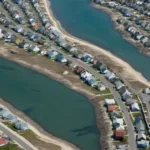11 December 2023
The Vulnerability of Alabama’s Gulf Coast to Sea Level Rise
Alabama’s Gulf Coast, with its pristine beaches and thriving tourism industry, has long been a beloved destination for locals and visitors alike. However, the region now faces an existential threat in the form of rising sea levels caused by climate change. As global temperatures continue to rise, the melting of polar ice caps and thermal expansion of seawater are leading to a steady increase in sea levels. The consequences of this phenomenon are becoming increasingly evident along Alabama’s coastline, with severe implications for the economy, infrastructure, and the livelihoods of those who call this region home.
1: The Economic Toll of Rising Sea Levels
Rising sea levels pose a significant economic risk to Alabama’s Gulf Coast. The tourism industry, a major source of revenue for the region, relies heavily on the allure of the pristine beaches. However, as sea levels rise, coastal erosion accelerates, and storm surges become more frequent and severe, the very foundation of this industry is under threat. A study conducted by the University of Alabama estimates that a one-meter rise in sea levels could result in a loss of $1.9 billion in property value and a decline of 17% in tourism-related revenue.
2: Infrastructure Challenges and Adaptation Efforts
The rising sea levels also present substantial challenges to the infrastructure of Alabama’s Gulf Coast. Roads, bridges, and other critical infrastructure are at risk of being inundated by water, leading to disruptions in transportation and increased maintenance costs. The city of Mobile, for example, has already experienced flooding in low-lying areas during high tides, causing damage to roads and homes. To mitigate these risks, local authorities are implementing adaptation measures such as elevating roads and buildings, constructing seawalls, and implementing stormwater management systems. However, these efforts require significant financial resources and long-term planning.
3: Environmental Impact and Loss of Biodiversity
The ecological consequences of rising sea levels are equally concerning. Alabama’s Gulf Coast is home to diverse ecosystems, including marshes, estuaries, and barrier islands, which provide habitat for numerous plant and animal species. As sea levels rise, these fragile ecosystems are at risk of being submerged, leading to the loss of biodiversity and the disruption of delicate ecological balances. Additionally, the intrusion of saltwater into freshwater systems can have detrimental effects on aquatic life and vegetation, further exacerbating the ecological impact.
4: Social Displacement and Community Resilience
The effects of rising sea levels extend beyond the economy and the environment. Coastal communities along Alabama’s Gulf Coast are facing the prospect of displacement as their homes and livelihoods are threatened by encroaching waters. Low-income communities, in particular, are disproportionately affected, as they often lack the resources to adapt and relocate. The loss of homes, cultural heritage, and community cohesion poses significant challenges to the social fabric of these communities. Efforts are underway to build community resilience, including the development of affordable housing in safer areas and the establishment of community-led adaptation initiatives.
5: Collaborative Solutions and Policy Implications
Addressing the challenges posed by rising sea levels requires collaborative efforts at the local, state, and national levels. In Alabama, the Coastal Alabama Partnership has been instrumental in bringing together stakeholders from various sectors to develop strategies for adaptation and resilience. The organization advocates for policies that prioritize coastal protection and sustainable development. At the national level, initiatives such as the National Oceanic and Atmospheric Administration’s Coastal Zone Management Program provide funding and technical assistance to states to support coastal resilience planning.
Conclusion:
The rising sea levels along Alabama’s Gulf Coast present a multifaceted challenge that requires urgent attention and action. The economic, infrastructural, environmental, and social implications of this phenomenon demand a comprehensive response that combines adaptation measures, policy changes, and community engagement. While the future of Alabama’s coastline may seem uncertain, the determination and resilience of its communities offer hope for a sustainable and resilient future. However, time is of the essence, and concerted efforts must be made to mitigate the impacts of climate change and safeguard the Gulf Coast for generations to come.



